Iceland: How much things cost & how to visit on a low budget
Since its currency crash in 2008, Iceland had gone from absurdly expensive to somewhat reasonable in cost, and that has prompted thousands of new tourists to stream in to see what all the fuss is about. It’s hard to find a visitor to Iceland who didn’t absolutely love the place, but you won’t find anyone who tells you it’s cheap, so planning ahead is essential. Prices have continued to creep up in 2015 and 2016, so it’s again among the most expensive European destinations.
Many visitors arrive on an Iceland stopover going between North America and Europe, but with very cheap flights to and from Europe it’s becoming popular for adventurous types from all over the continent. In 2013 I spent 9 days in the country, always checking for prices and the cheapest ways of doing things, so below I can lay out how to budget and what to do to keep costs down.
Note: This article was first written in late 2013, but all prices have been updated as of December 2016 to be current through 2017.
Reykjavik vs. the rest of Iceland: Where to go
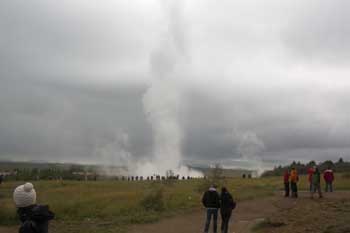
If you have one night or a few nights you are better off taking a bus or renting a car directly from the airport and heading east along the southern coast for some of the country’s best sights. If you have at least a week you’ll want to rent a car and do a lap around Iceland’s famous Ring Road, allowing you to see nearly everything the country has to offer in a neat and organized way.
Iceland accommodation: Hostels, guesthouses, and hotels
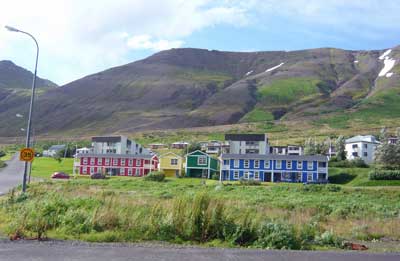
The most common form of accommodation in Iceland is a guesthouse and hostel combination which will have a mix of private rooms and dorm rooms, with shared bathrooms in down the hall. Most of them have fully equipped shared kitchens, so self-catering is at least as popular as eating out while exploring Iceland outside of Reykjavik.
High season (June through August) typical accommodation prices
All prices quoted in US dollars at a rate of about 110 Krona to US$1 in December, 2016.
- Hostel dorm bed: US$34 to US$58
- Single private with shared bathroom: US$85 to US$135
- Double private with shared bathroom: US$118 to US$140
- Double private with en-suite: US$130 to US$320 (and up)
Prices in Reykjavik are a bit higher than elsewhere in the country, but not by much. Prices in the off season are about 30% lower than in high season, but in the slowest months many places close so rates never go much lower than this.
Most Iceland guesthouses are NOT on the normal hotel-booking sites
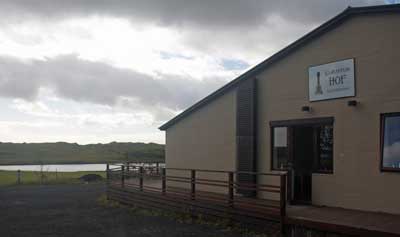
The good news is that when you get to Iceland, the tourism office will give you a directory of almost every guesthouse on the island, and there are other ways of finding these guesthouses and other informal accommodations. Even as of late 2016 you should be able to book a double room (with shared bathroom) for about US$120 per night in most towns in Iceland. If you do a hotel search you might see prices that are double that, but those are in the few formal hotels with 24-hour lobbies and such.
Increasingly, Airbnb and other online rental sites are the best place to find guesthouse accommodation in Iceland. As of only a few years ago, most places would be booked by phone or in person on arrival day, but now more and more places can be pre-booked, at reasonable prices.
Sleeping bag accommodation in Iceland
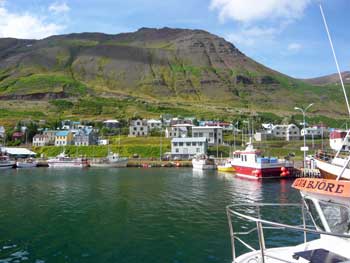
In a ‘sleeping bag accommodation’ (as it’s known in Iceland) you’ll get a bed with a mattress and often a pillow. So with even a cheap indoor sleeping bag, you’ll be comfortable and warm while saving quite a bit of money. For those renting cars, this is a highly recommended strategy.
You can rent sleeping bags in Reykjavik starting at around €12 per week.
Most Iceland attractions are free (the good news)
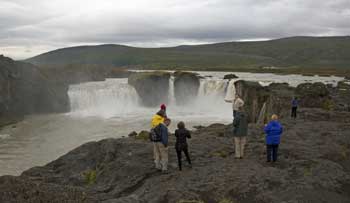
So to see all the glaciers and waterfalls and volcanic beds and other scenic attractions, it’s all free of charge with no admission cost or even parking fees. The larger attractions also have visitor centers where you can get local advice for free as well.
Iceland transportation: Rental cars and buses
Even as a lifetime public transportation fan, I’m very glad I gave in and rented a car to tour Iceland, even as a solo traveler. For the most part the roads are in perfect condition and virtually empty even in high season, so driving couldn’t be easier. Also, the country has stunning vistas every time you turn a corner, so being able to stop in the middle of the road even if there is no room to pullover, is critical.
The buses are modern but also expensive and running on very limited schedules. If you only have enough time to cover the main sights along the southern coast you might buy one of the bus passports that allows you to hop on and hop off, though a rental car is still much better and easier.
Rental cars in Iceland: What you need to know
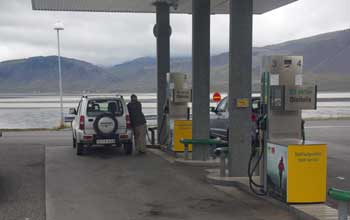
For an extra fee you can pay to reduce that deductible to almost nothing, but the more popular add-on is the Gravel and Glass insurance. For around €10 per day with this coverage you have a zero deductible if the vehicle gets damaged by gravel or if any glass gets broken by flying rocks (or anything else). Unfortunately, many of Iceland’s side roads and even a few of the main roads are covered in gravel, and if you drive at anything above a crawl, there will be some gravel flying around.
Personally, I normally decline add-ons like this but in this case I bought the Gravel coverage after reading a few horror stories in online reviews. I didn’t get any damage that I’m aware of, but the peace of mind was worth a LOT when driving on isolated gravel roads so I wasn’t petrified that I was chewing up the paint job just trying to stay safe on the roads.
Rental cars in Iceland
- 2-wheel drive compact (manual): US$230 per week and up plus add-ons
- 2-wheel drive compact (automatic): US$270 per week and up plus add-ons
- 2-wheel drive mid-size: US$450 per week and up plus add-ons
- 4-wheel drive van or SUV (automatic): US$650 per week and up plus add-ons
Daily rates are about 20% as much as weekly rates, so 5, 6, or 7 days cost the same.
Add-ons
Gravel coverage: US$10/day
GPS (highly recommended): US$10/day
Additional collision waiver: US$10/day
Fuel prices in Iceland
Every gas station in the country has the same prices, which don’t seem to change much. As of December 2016, a liter of petrol is 194 Krona, which is about US$1.75 or €1.63, or about US$7.50 per gallon.
Bus pass prices in Iceland
For a quick day trip from the airport to some local sights you can spend as little as US$90 per person, but for the longer distance buses you’ll spend at least US$130 to US$250 depending on length of time in order to hop on and hop off.
A Ring Road passport will cost around US$400 per person, so for two people it’s no cheaper than renting a car, even after fuel is taken into account, and for 3 or 4 people it’s definitely cheaper renting a car.
Food prices in Iceland
Here’s the thing: sit-down restaurants in Iceland are very expensive by international standards, so there aren’t very many of them. Obviously Reykjavik has many restaurant choices but most smaller towns might have only a few at most. The good news for budget travelers is that fast-food options are more plentiful, and self-catering is even cheaper and easier.
Restaurant prices in Iceland
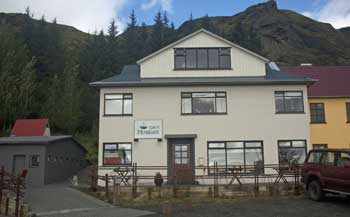
A soft drink, coffee, tea, or even bottled water will generally be between US$3 and US$5 in a restaurant. A pint of beer will typically start at around US$7 at even the cheapest places, while wine and spirits cost even more.
Fast food prices in Iceland
In Reykjavik and larger towns (which might only have 2,000 residents) you’ll have many fast food options including Subway, Quiznos, and usually a few local burger or hot dog places. Prices for a sandwich at Subway are about US$6 for a 6-inch and US$10 for a foot-long, so they aren’t too much higher than elsewhere in Europe, and are sure cheaper than proper restaurants.
More good news for drivers is that many gas stations around the country have fast food restaurants built in, so it’s fast and easy to pick up a sandwich or hot dog by the side of the road.
Hotel breakfast prices in Iceland
Many hotels and guesthouses in Iceland serve breakfast, but it’s almost always at an extra fee, and many don’t serve anything at all. If a breakfast is offered it will typically cost between US$12 and US$15 for a buffet of cereals, bread, cold cuts, cheeses, hard boiled eggs, juices, coffee and tea, and perhaps some pastries.
Making your own self-catering breakfast will be cheaper, but since you can stuff yourself for a flat fee at the breakfast buffets it might be worth it to save yourself the hassle of shopping the day before and making breakfast in the morning.
Self-catering in Iceland
The best budget tip for Iceland is to buy and prepare your own food, and you can literally do it for all three meals per day if you prefer. Since Iceland has almost no national “must-try” dishes, you can buy and prepare your own food without worry about missing anything meaningful.
Nearly every guesthouse in Iceland has a shared kitchen where at least half the guests will be storing and preparing breakfasts and even dinners. They have refrigerators, coffee makers, electric kettles, pots, pans, dishes, and silverware, as well as salt and other spices, so you can buy just the food and you’ll be able to prepare it all.
Supermarket prices in Iceland

For example, you can buy a 400 gram (1 pound) block of Havarti cheese for around US$5, but a similar looking cheese right next to it on the shelf might be US$15 for the same amount. The same is true for lunch meats. Sliced ham can be US$3 for enough to make 2 sandwiches, but sliced roast beef might be US$10 for the same amount.
Some sample prices in the cheaper Iceland supermarkets
- Sliced white bread: US$1.70 per large loaf
- Fresh baguette: US$1.50 to US$2 each
- Hot dog buns: US$2.50 for 5
- Pork hot dogs: US$3.50 for 5 large hot dogs
- Cheap Havarti or other local cheese: US$5 for 400 grams (1 pound)
- Imported cheese: US$10 to 15 for 400 grams (1 pound)
- Sliced ham for sandwiches: US$5 for 400 grams (1 pound)
- Sliced roast beef for sandwiches: US$12 for 400 grams (1 pound)
- Pasta: US$1.50 for .5 kilogram (1.1 pounds)
- Pasta sauce: US$3 for a .5 liter jar
- Ground beef: US$5 for .25 kilos (half pound)
- Bake-at-home pizza: US$5 to US$7 for one person
- Bag of tortilla chips for 2 or 3 people: US$2
- Jar of salsa for those chips: US$3
- Breakfast cereal: US$3 to US$5 per box
The prices above are for many of the cheaper and more common things that budget tourists buy in Iceland. As mentioned above, if you want something exotic and imported, it might cost double or triple what you pay at home, if you can find it at all.
Alcohol prices in Iceland
In restaurants and bars throughout the country you’ll pay at least US$8 for a pint of beer, and at least US$10 for a glass of wine or a simple cocktail. If it’s a fancy place you’ll pay even more, of course.
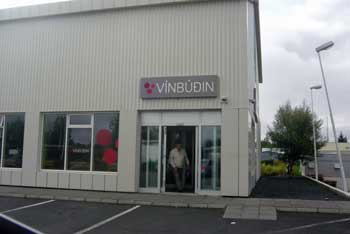
Here are some typical prices for alcohol:
- 330ml can of local beer: US$2 to US$3
- 500ml can of local beer: US$2.50 to US$4
- Cheapest bottle of wine: US$10 to US$12
- .7L bottle of off-brand vodka: US$30
- .7L bottle of mid-level brand vodka: US$50
Bottom line on doing Iceland as cheaply as possible
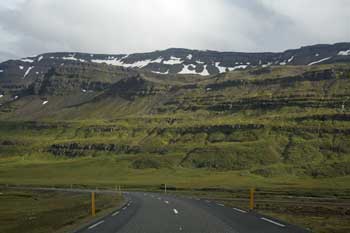
Whether you are going to get dorm beds or private rooms, as long as you will have your own wheels it’s worth renting a sleeping bag. You get the same bed and same services for about US$10 less per night, which will pay for a week’s rental of an indoor sleeping bag.
Unless you are a terrible driver or afraid to drive, it’s highly recommended to rent a car instead of trying to get around using buses. Once you get there you’ll see that having 100% flexibility with a car compared to almost no flexibility with a bus, is worth a LOT.
Instead of trying to be cheap with transportation, be cheap with self catering food and drinks for yourself. If you have at least a small group of people you’ll be able to have a party each evening in or near the shared kitchen of your guesthouse, and it will be more lively than any restaurant in town.

Thank you for this information – very helpful!
We are going to Iceland soon – will be driving a rental car for a day in Keflavik & Reyjavik; then driving an RV (giving flexibility) for a week around the Ring Road. The food prices you listed are similar to where we live (Hawaii)….mahalo!
Hi Roger!
Thanks for posting such useful information about Iceland!!
I am visiting in May for 6 days, and would like to try to do the ring road, or at least part of it… I have been trying to decide if I want to rent a car or just hitch-hike. It sounds like you think it’s pretty safe?
Also, do you know if it’s common for hostels to allow you to do a bag check? I wouldn’t want to take much of value with me while hitching…
Thanks so much!!
-LT
LT,
As I mentioned just above this, I was planning a solo trip to Iceland and I was trying to decide between renting a car on my own, and taking the public buses. I’m extremely glad I chose to rent a car as it became obvious that it allowed so much more freedom to explore where and when I wanted.
My sense is that hitchhiking in Iceland is about as safe as it is anywhere in the world. It’s a very safe and quite wealthy country with a small population. Even the tourists are fairly well off because it’s not cheap to get there from anywhere else, nor is it cheap to stay there. And as far as I could tell, everyone speaks English, from the locals to the other tourists.
My one concern about hitchhiking in May would be that it’s before the main tourist season and you might have to wait for some rides. I visited in late August, which is also after the main season, and there were very few cars going anywhere except for along the southern coast. With 6 days you might only have time to explore the southern coast so it could work out okay. In other words, if you wanted a ride from the northwest corner to the northeast corner one day, it might take a few hours before someone who is going that whole way and has room for you would come by. Or if you stayed at a larger hostel or guesthouse, you might be able to ask enough people there to find another guest going that exact direction, so it could be easy. One nice thing about Iceland, and especially the Ring Road, is that there are very few options, so most of the traffic is going to the same place, or just coming from that place.
So bottom line, I think it’s safe, and it should be easy, but not necessarily for every ride at the exact moment you are ready to go.
And as for stowing your bag at a hostel, that shouldn’t be a problem at all. As long as you book yourself into a place that gets decent reviews and is oriented towards budget travelers (and these are common), then probably many guests do that every day. The hostels and guesthouses in Iceland tend to be pretty big, at least compared to hostels in cities like London or Paris, so they should all be able to have a secure room for left luggage for paying guests. Have fun. -Roger
Hi there – One thing that was not mentioned is that Tax and Tip are included when dining out. Once i calculated what i would have added for those things, I found many casual restaurants were quite the same as here in Canada at least. My family and I had fish and chips one night and it ended up being that same as what we would have spent at home.
Ky,
That’s an interesting point. Tax is included in the quoted price almost everywhere in the world except the US and Canada, and tipping is usually smaller as well. So the prices I list are basically the final price in a place like Iceland, which makes them a bit more affordable than they might seem to some of us. -Roger
Hi Rodger,
I am considering visiting Iceland in May of Next year and am hoping to spend 3-4 weeks there. I plan to spend as much time hiking and camping as possible, but I know there will be inevitable hostel stays (especially over a 3-4 week period). I am a solo traveler, so splitting costs with friends is not going to work for me.
My first question to you would be this: Do you think 3-4 weeks is too much time for a budget traveler like myself, or should I look to shorten my stay to 2 weeks? I have a post airfare budget of about $2,000 USD. I’m thinking if I only rent a car for a week to 10 days and spend the rest of my time staying in or near Reykjavík or taking buses to a hiking trail terminus or town, that could save me a bit of money.
My second question would be about the sleeping bag stays. Are those offered just about anywhere in Iceland or just in the major towns? I would like to spend as much time as I can enjoying the countryside which I assume would take me to more remote villages than towns. Also, is this a well advertised option, or will I need to know where to look for those sort of accommodations?
Thank you for all of your very helpful information on this page. It’s made me realize that visiting Iceland may not be as financially difficult as I thought it may be.
Thanks again,
Brian
USA
Brian,
Iceland is one of my favorite places anywhere, and I’m happy to try to help other people visit with more information on what things really cost there, partly because so much of it was a mystery until I got there myself.
First off, 3 or 4 weeks actually does sound like a long visit, but if you are going to be hiking and camping most of the time, I really doubt you’d get bored. The scenery is amazing and so varied from one area to the next that there’s always something wonderful around the next corner.
Based on what you have in mind for a stay of that length, I honestly think you might consider hitchhiking around the Ring Road. From what I read, it’s extremely safe and normal there. Having read that, I was actually ready to pick up any hitchhikers I saw in my own rental car, but I didn’t see one until I was close to Reykjavik again at the end, and not going where they wanted. I went in late August, which is the end of the travel season, and your plan to go in May is the beginning, so it would be similar. Except for the Reykjavik area, the whole rest of the island feels like a huge national park, and there are so few roads that pretty much everyone is going your way, or the opposite direction. Read up on it and if it’s something you are comfortable doing, there’s probably no better place in the world for it.
Also, if/when I go back to Iceland for a longer trip like you have in mind, I’ll want to spend even more time going around the Ring Road. The city of Reykjavik itself is nothing special and you can see the main sights in one day or so. The famous attractions close to Reykjavik (except for the Blue Lagoon) are among the more disappointing compared to those around the rest of the island. You could spend 3 weeks going around the Ring Road (hitchhiking or on buses) and it would still feel like it was going by pretty fast. The best thing about renting a car is that you can obviously go at your own pace, and do the whole ring in a week or less. But there were a few days where I was driving for maybe 8 hours, and even skipping some waterfalls or other sights just to stay on schedule.
The “sleeping bag accommodation” is popular all over Iceland, although not necessarily in every town. In other words, if you wanted to try to find a cheap room like that every night, you could probably do it, but you might have to choose one town over another to achieve it. Finding guesthouses in Iceland can be a challenge in general. When you get there you’ll get a free catalog that lists pretty much every hotel and guesthouse in the country, but you still have to call or email them to get the rates and details. I booked a few places online (through Kayak.com) and a few other places I just drove there late in the afternoon to see what was available. Again, it was after the peak season, so I was never too worried about having to sleep in my car.
In the end, I think I found sleeping bag accommodation for 2 or 3 nights, and regular hotels for the other 4 or 5 nights on the Ring Road. They are often the same places, it’s just that some guesthouses will charge less if they don’t have to change the sheets and all that. If you are on more of a relaxed schedule, I’d think that you could call a few places in the town you are headed to, and find something fairly cheap, and it will often be a sleeping bag place.
Lastly (for now), it’s quite easy to eat on a very low budget if you buy supplies at the little supermarkets all over the island, and prepare your meals in the community kitchen that pretty much every guesthouse and hotel has. And of course all the sights are free, so once you figure out sleeping and transport, Iceland can be a cheap place to visit.
Feel free to ask any other questions. They make me want to visit Iceland again sooner. -Roger
Hi Rodger,
I am going to be going to Iceland in May. I was considering renting a car and doing one of those self-drive 8 day Ring Road prepackaged deals. I am a very good driver, but I have had second thoughts because I would be traveling alone. I have looked into a guided group trip that is 8 days in a tour bus that travels the Ring Road. A number of meals are included, breakfast and most dinners. It is slightly cheaper than if I purchased the self-drive package. Wondering your opinions on traveling to Iceland alone. I am a fairly seasoned traveler, but have never been to Iceland. Cost is an issue for sure but also the unknowns of traveling alone in a country you know nothing about.
Thanks,
Alex
USA
Alex,
I’m actually not aware of the pre-packaged self-drive Ring Road deals, but I did research the bus options before my own trip to Iceland. As I might have said in the article, I decided to rent a car and do it all on my own, and I’m VERY glad I did. Most aspects of it were quite easy, and the extra freedom of being able to go at my own pace was amazing.
One important detail that I only learned once there is that the area around Reykjavik is a little bit crowded, and the roads between Reykjavik and Hofn in the southeast corner have quite a few vehicles going back and forth, but the rest of the island (and Ring Road) is almost empty. I was there toward the end of the season, but it was still in season, and I sometimes went 30 minutes without seeing another car in either direction as I’d drive. That was one of the most amazing parts of it, to go along with the jaw-dropping scenery. Literally dozens of times I would be driving and would round a corner and see some waterfalls or peaks or some other postcard view, and I’d just stop my car in the middle of the road to take a few photos. On a bus you’d obviously be traveling with a couple dozen people, and only stopping at the main landmarks and predetermined vista points.
One downside of driving a car on my own is that there are very few road signs in Iceland, and they are all in Icelandic, which feels quite unfamiliar to most of us. On the other hand, getting around the Ring Road is usually a matter of “Turn left and then go 80 kilometers to the next tiny town, or pull over after 49 kilometers to see a scenic waterfall just at the side of the road.” In other words, it’s hard to get lost, even without many signs. I got the GPS option in my rental car (for free because my car was late for pickup) and I’m very glad I did because it made everything very easy. I was going to use my iPhone as a GPS, and that would have done a decent job, especially if I had some sort of dash mount for it.
And the Ring Road itself is in perfect condition around most of the island, although there are still a few spots where it becomes a gravel road, and a few main sites that are only accessible by gravel roads. I never felt any danger, and even if my car had broken down or blown a tire, there would be someone by to help within an hour or so, even on most side roads (as long as you travel during normal hours).
As far as costs are concerned, I don’t know what the package deal includes, but I have a feeling you could spend less on food and drinks on your own. All over Iceland, a sit-down meal is going to cost US$12 to US$20 for even something basic, and twice that much for a traditional evening meal (as opposed to a sandwich or pasta etc). But, you can get sandwiches and pizza and other casual items at fast food places, which are often inside petrol stations (every 30km or so). I did that for lunch most of the time, and for most breakfasts and many dinners I’d buy groceries and prepare something at the common kitchen that almost every guest house or hotel has. The Icelandic food doesn’t win many prizes, so it’s not a country where you’ll drool as each next meal draws near.
So I definitely recommend going on your own as opposed to a bus, and it should be quite easy and stress-free. Everyone you meet speaks fluent English, and pretty much all tourists to Iceland speak English, so it’s easy. If the package including a car and hotels and meals seems like a good deal, it might be a good choice. But if it seems pricey for what you get, you can probably do better on your own, especially in May since it’s early in the season. By the way, all the sights (except the Blue Lagoon) are totally free, and there is free parking everywhere as well.
In case you can’t tell, I loved my Iceland trip and can’t wait to go back. Feel free to ask anything else and I’ll be happy to chime right back in. -Roger
Thanks again Roger. I emailed Avis and they responded that all the coverages (from them) are optional/extra. When I did my rental search, only Thrifty included CDW and Theft coverage.
Hi. First of all I must say this is the most useful website on Iceland I’ve come across! But I have a question. I’m booking my rental through Avis. And they’re offering CDW as an option. Are they just trying to make more money off of me? Cos a 10 day rental is already over 1k! Thanks!
Kura,
Thank you for the kind words and I’m glad this information is helpful.
As for the Iceland car rental, my understanding is that a general Collision Damage Waiver is mandatory for all rentals in Iceland, but that one has a deductible of €1,500 (I believe). When I rented from Sixt Car Rental (and had a great experience with them) they offered me a zero deductible add-on for around €9 extra per day. Yours is probably the same.
Personally, I did NOT get the extra zero-deductible coverage, and I’m glad I did. The chance of a major accident or theft are extremely low on such empty roads. But I did get the extra gravel-damage waiver for about the same amount, and even though I normally avoid those, I’m glad I got it that time even though I didn’t need it in the end. If you are going around the Ring Road in Iceland, many of the most interesting sights are only accessible by gravel road, and at one point I drove about 40 kilometers on one to avoid having to backtrack 200 kilometers to reach the paved road again. When you are driving on those gravel roads, the little rocks are flying around under the front of the car, and for me it was a nice feeling to know that I didn’t have to worry about potential damage. -Roger
How much money for a week would be minimum and realistic
Tessa,
That’s a very difficult question to answer without knowing more. For one thing, you’d never want to just stay in Reykjavik for a whole week, so you have to figure in transportation. Renting a car is expensive, but for 2 to 4 people, it’s probably worth it and also a better option than buses.
I’d say that WITHOUT transportation costs, you could get by on as little as US$70 per day if you sleep in hostel dorms, make some of your own meals or eat from fast food joints, and don’t drink alcohol. All the hostels and many hotels have community kitchens, and cooking for yourself is very popular in Iceland because there are so few affordable restaurants (and the local food doesn’t have a great reputation).
The best part is that pretty much all the sightseeing is totally free once you have transportation. All the waterfalls and hiking trails and hot springs and such are free to enter, not including the Blue Lagoon itself. If you have more specific questions I’ll try to answer them if I can. -Roger
Thank you so much for this informative article! We are travelling in September, so I was glad to see this is when prices might be a bit lower!
I am going to Iceland in three weeks and I find your tips very helpful. Thank you 🙂
Hi Izabela!
I hope you really enjoyed your travel around Iceland.
In early April myself, and two other women will also be travelling there together for about a week.
If you have any reccomendations or special highlights from your trip about accomodation, must see places, etc that you’d like to share with me, I’d love to hear about it!! 🙂
Kind regards,
Stacey